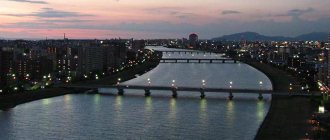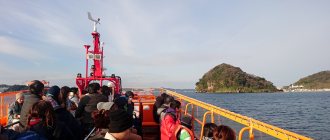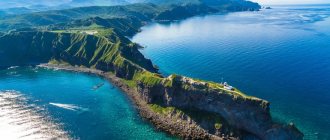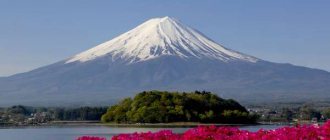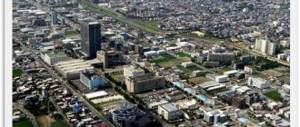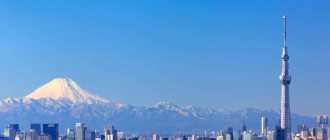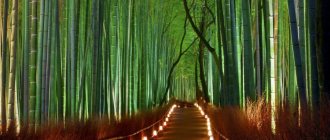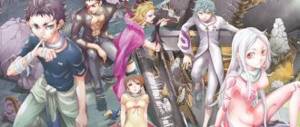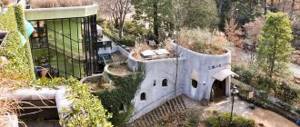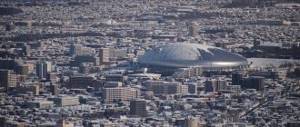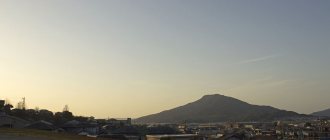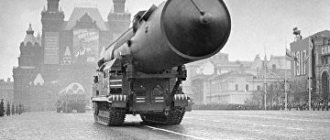With its huge cities and tall skyscrapers brightly lit with neon lights, Japan is as unusual as it is an interesting country to visit, full of history and a rich cultural heritage. A country where world-class restaurants coexist with ancient castles and imperial palaces, and cities are full of life and energy.
Wandering through cities like Tokyo, surrounded by beautiful natural scenery, is like stepping into the future, such is the innovation and technological know-how on display for the traveler.
I present to you my ranking of the 15 most interesting cities in Japan:
Matsue
Matsue Castle
Matsue City
Charming and full of cultural attractions, this samurai city is rich in history. Matsue, located on the shores of Lake Shinji, has a serene ancient feel as fishermen cast nets into the lake as a lazy river flows past.
There are several good museums worth visiting, and while the historic center can easily be explored in half a day, Matsue's peaceful atmosphere means travelers often choose to stay longer than planned.
Himeji
Himeji city in Japan
Himeji Castle. Japan
The imposing, commanding feudal-era fortress of Himeji-jo is considered Japan's finest castle and the main attraction of this quiet town. There are several beautiful samurai buildings nearby with their delightful traditional gardens.
Apart from a couple of museums, there isn't much to do in Himeji, although there are the usual shrines, temples and restaurants that aren't too different from those in other Japanese cities. An easy day trip to a number of attractions will make you fall in love with this glorious town of Himeji.
Nagano
Nagano is located in the northern part of Nagano Prefecture. It is the site of the 1998 Olympic and Paralympic Games.
The most popular tourist spot in Nagano is probably the Zenko-ji Temple. It is believed that Zenko-ji Temple was founded approximately 1,400 years ago during the Asuka period. The main hall of the temple was named a national treasure in 1953. It is important from an architectural point of view, so the temple may be of interest even to people who are not interested in temples and shrines. In addition, in Chusa in the Togakushi-jinja temple there is a cedar tree, which is 700 years old, and in the Iwamatsu-in temple you can look at the phoenix “Ho-ou-zu”, which was painted by a Japanese artist of the Edo period (1603-1868). d.) Katsushika Hokusai.
Nagano boasts rich nature, especially Lake Nojiri and the Kagami-ike Reflecting Pool. Fossilized remains of the now extinct Nauman-zo elephants were discovered in Lake Nojiri, which can be seen at the Nojiri-ko Naumann Elephant Museum on the headland near the lake.
Beppu
Hot springs in Beppu. Japan
The amazing city of Beppu
Beppu is a charming and welcoming place where travelers invariably stop to relax and soak in the city's many hot springs. The city has more than three thousand springs, and life in Beppu is largely focused on the tourism and leisure sector.
Steam and fog floating through the streets create a magical effect in the air of the city, which is located on the coast surrounded by mountains.
List of cities in Japan
| # | Name, city | Population, people |
| 1 | Tokyo | 8 967 741 |
| 2 | Yokohama | 3 681 315 |
| 3 | Osaka | 2 668 200 |
| 4 | Nagoya | 2 259 780 |
| 5 | Sapporo | 1 896 223 |
| 6 | Kobe | 1 538 924 |
| 7 | Kyoto | 1 463 482 |
| 8 | Fukuoka | 1 461 686 |
| 9 | Kawasaki | 1 420 393 |
| 10 | Saitama | 1 220 754 |
| 11 | Hiroshima | 1 181 141 |
| 12 | Sendai | 1 060 356 |
| 13 | Kitakyushu | 981 162 |
| 14 | Chiba | 960 649 |
| 15 | Sakai | 839 021 |
| 16 | Niigata | 811 894 |
| 17 | Shizuoka | 715 904 |
| 18 | Sagamihara | 714 193 |
| 19 | Okayama | 705 446 |
| 20 | Kumamoto | 670 442 |
| 21 | Kagoshima | 605 267 |
| 22 | Funabashi | 586 782 |
| 23 | Hachioji | 567 450 |
| 24 | Kawaguchi | 552 921 |
| 25 | Himeji | 536 195 |
| 26 | Matsuyama | 515 140 |
| 27 | Higashiosaka | 509 212 |
| 28 | Utsunomiya | 507 887 |
| 29 | Matsudo | 477 661 |
| 30 | Nishinomiya | 477 082 |
| 31 | Kurashiki | 472 490 |
| 32 | Ichikawa | 470 243 |
| 33 | Oita | 467 316 |
| 34 | Fukuyama | 461 451 |
| 35 | Amagasaki | 461 238 |
| 36 | Kanazawa | 455 687 |
| 37 | Nagasaki | 448 875 |
| 38 | Yokosuka | 421 447 |
| 39 | Toyama | 421 130 |
| 40 | Toyota | 420 362 |
| 41 | Takamatsu | 419 486 |
| 42 | Machida | 413 874 |
| 43 | Gifu | 412 842 |
| 44 | Hirakata | 406 266 |
| 45 | Fujisawa | 402 699 |
| 46 | Kashiwa | 389 120 |
| 47 | Toyonaka | 387 309 |
| 48 | Nagano | 378 256 |
| 49 | Toyohashi | 377 079 |
| 50 | Ichinomiya | 375 951 |
| 51 | Wakayama | 372 230 |
| 52 | Okazaki | 371 429 |
| 53 | Miyazaki | 369 484 |
| 54 | Nara | 367 438 |
| 55 | Suita | 354 677 |
| 56 | Takatsuki | 354 303 |
| 57 | Asahikawa | 350 592 |
| 58 | Iwaki | 350 026 |
| 59 | Kochi | 342 993 |
| 60 | Takasaki | 341 906 |
| 61 | Koriyama | 339 445 |
| 62 | Tokorozawa | 338 637 |
| 63 | Kawagoe | 335 763 |
| 64 | Akita | 329 307 |
| 65 | Otsu | 329 086 |
| 66 | Koshigaya | 318 645 |
| 67 | Maebashi | 318 127 |
| 68 | Naha | 314 190 |
| 69 | Yokkaichi | 306 669 |
| 70 | Aomori | 305 967 |
| 71 | Kurume | 305 242 |
| 72 | Kasugai | 300 811 |
| 73 | Morioka | 299 802 |
| 74 | Akashi | 292 227 |
| 75 | Fukushima | 289 400 |
| 76 | 289 262 | |
| 77 | Shimonoseki | 286 122 |
| 78 | Nagaoka | 281 321 |
| 79 | Ichihara | 279 688 |
| 80 | Hakodate | 277 089 |
| 81 | 273 319 | |
| 82 | Ibaraki | 272 317 |
| 83 | Fukui | 268 647 |
| 84 | Kakogawa | 267 651 |
| 85 | Tokushima | 266 381 |
| 86 | Mito | 264 104 |
| 87 | Hiratsuka | 260 475 |
| 88 | Yamagata | 255 411 |
| 89 | Sasebo | 254 664 |
| 90 | Futu | 248 527 |
| 91 | Kure | 246 196 |
| 92 | Hachinohe | 241 700 |
| 93 | Saga | 239 991 |
| 94 | Neyagawa | 239 114 |
| 95 | Juice | 237 983 |
| 96 | Fuji | 237 295 |
| 97 | Kasukabe | 236 935 |
| 98 | Chigasaki | 231 045 |
| 99 | Matsumoto | 227 424 |
| 100 | Atsugi | 225 252 |
| 101 | Yamato | 223 177 |
| 102 | Ageo | 222 555 |
| 103 | Takarazuka | 222 154 |
| 104 | Chofu | 219 068 |
| 105 | Ota | 214 116 |
| 106 | Tsukuba | 207 366 |
| 107 | Numazu | 206 835 |
| 108 | Joetsu | 206 247 |
| 109 | Kumagaya | 204 896 |
| 110 | Isesaki | 204 266 |
| 111 | Kishiwada | 200 606 |
| 112 | Tottori | 200 348 |
| 113 | coffee | 199 404 |
| 114 | Odawara | 198 938 |
| 115 | Suzuka | 197 507 |
| 116 | Matsue | 195 954 |
| 117 | Hitachi | 195 861 |
| 118 | Itami | 194 513 |
| 119 | Nishitokyo | 193 364 |
| 120 | Yamaguchi | 192 037 |
| 121 | Uji | 191 370 |
| 122 | Higashihiroshima | 187 771 |
| 123 | Hirosaki | 185 897 |
| 124 | Kodaira | 185 880 |
| 125 | Yachiyo | 184 744 |
| 126 | Kushiro | 182 303 |
| 127 | Mitaka | 180 821 |
| 128 | Hino | 179 535 |
| 129 | Izumi | 179 450 |
| 130 | Takaoka | 179 015 |
| 131 | Ube | 176 406 |
| 132 | Anjo | 176 069 |
| 133 | Tachikawa | 175 698 |
| 134 | Tomakomai | 173 832 |
| 135 | Kamakura | 173 665 |
| 136 | Iwata | 172 609 |
| 137 | Sakura | 171 567 |
| 138 | Imabari | 171 057 |
| 139 | Matsusaka | 169 654 |
| 140 | Miyakonojo | 169 441 |
| 141 | Hadano | 169 299 |
| 142 | Obihiro | 168 273 |
| 143 | Ishinomaki | 163 851 |
| 144 | Ogaki | 163 126 |
| 145 | Oyama | 162 344 |
| 146 | Ueda | 161 962 |
| 147 | Toyokawa | 161 609 |
| 148 | Narasino | 159 776 |
| 149 | Urayasu | 159 391 |
| 150 | Ashikaga | 157 855 |
| 151 | Kawanishi | 157 549 |
| 152 | Nagareyama | 156 718 |
| 153 | Sayama | 156 698 |
| 154 | Niiza | 155 974 |
| 155 | Hitachinaka | 155 358 |
| 156 | But yes | 153 483 |
| 157 | Xionang | 150 347 |
| 158 | Tama | 149 482 |
| 159 | Yonago | 149 150 |
| 160 | Komaki | 149 122 |
| 161 | Iruma | 148 271 |
| 162 | Onomichi | 148 136 |
| 163 | Iwakuni | 146 915 |
| 164 | Higashimurayama | 146 663 |
| 165 | Moriguchi | 146 324 |
| 166 | Fukaya | 146 203 |
| 167 | Izumo | 146 140 |
| 168 | Kakamigahara | 145 143 |
| 169 | Kariya | 145 163 |
| 170 | Koga | 144 445 |
| 171 | Tsuchiura | 144 070 |
| 172 | Isahaya | 142 728 |
| 173 | Ome | 141 767 |
| 174 | Kuwana | 140 830 |
| 175 | Tsuruoka | 140 147 |
| 176 | Musashino | 138 602 |
| 177 | Inazawa | 137 536 |
| 178 | Osaka | 137 258 |
| 179 | Yatsushiro | 134 564 |
| 180 | Ise | 133 640 |
| 181 | Abiko | 133 576 |
| 182 | Nobeoka | 132 495 |
| 183 | Seto | 132 335 |
| 184 | Iizuka | 132 271 |
| 185 | Otaru | 130 336 |
| 186 | Kadoma | 130 051 |
| 187 | Fujieda | 129 734 |
| 188 | Aizuwakamatsu | 129 437 |
| 189 | Karatsu | 129 237 |
| 190 | Misato | 129 001 |
| 191 | Okinawa | 128 444 |
| 192 | Osyu | 128 337 |
| 193 | Minoo | 127 800 |
| 194 | Kirishima | 127 763 |
| 195 | Dzama | 127 614 |
| 196 | Omuta | 127 506 |
| 197 | Beppu | 127 402 |
| 198 | Asaka | 126 989 |
| 199 | Ebina | 126 061 |
| 200 | Daito | 125 898 |
The website chislennost.com uses information from official sources and is updated every month. Some data may vary due to the lack of the latest census.
Kobe
Kobe city in Japan
Kobe
Kobe is an attractive city, perched on a hillside by the sea, sandwiched between the water and Mount Rocco, which rises beyond it. A historic port, the city's small stature belies the cosmopolitan feel of its streets. Wandering around the area, you can find religious buildings dedicated to all major religions.
Kobe is a great place to explore great restaurants and cool cafes, as well as a vibrant nightlife. If you're using the city as a gateway to Japan, it's a smart decision, with many amazing attractions just in close proximity.
Ise
Ise is located in the eastern part of Mie Prefecture. The city of Ise is home to the Ise-Jingu Shrine. The temple is so famous that it can be said without exaggeration that every Japanese knows about it. The temple is dedicated to Amaterasu, one of the dominant beings in the Shinto pantheon. The goddess Amaterasu is associated with the sun, and therefore Ise-Jingu is considered close to the heart of every Japanese. Visiting Ise-Jingu has long been a goal for many Japanese. Even during the Edo period, when getting here was difficult and transportation was scarce, hundreds of thousands of people from all over Japan came to Ise-Jingu. The long journey to Ise-Jingu for the purpose of prayers may perhaps be the beginning of the concept of "travelling".
Ise-Jingu has two shrines: the outer Ise-Jingu-Geku and the inner Ise-Jingu-Naiku, and visitors to the shrine typically visit both of them in the above order.
After visiting Ise-Jingu, take a stroll along Okage-yokoutho Street in the Oharai-machi area. Here you can try delicious local tea and udon noodles. The contrast between the quiet and tranquility of Ise Jingu Temple and the bustling, busy streets of the area will make you feel like you're in two different worlds.
The closest stations to Ise are Ise-shi Station and Ujiyamada Station. However, traveling to these stations from remote areas may not be very convenient as the bullet train does not operate here. From the relatively nearby Nagoya, Osaka Uehonmachi or Kyoto Stations, Ujiyamada Station is a 2-hour train ride. There is no airport in Mie Prefecture, so the closest airport is Chubu International Airport in Aichi Prefecture.
Nagasaki
Nagasaki city in Japan
Nagasaki
The picturesque location, peacefully set among the hills overlooking the harbour, hides the fact that the city was tragically destroyed by an atomic bomb. While many visitors come to wander through bombing memorials and museums, Nagasaki has much more to offer; it's a vibrant, cosmopolitan city with plenty to see and do.
The city was once the only port open to foreign traders, and this openness is still evident; There is a mix of Western and Eastern influences here, as evidenced by the churches, temples and cuisine offered to travelers.
Yokohama
Yokohama
Yokohama city in Japan
Even though Yokohama is less than half an hour from Tokyo, it certainly has its own personality and, as Japan's second largest city, is worth a visit. Situated on the shores of a beautiful bay, it is a vibrantly cosmopolitan city, as evidenced by its large expatriate community, wealth of different architectural styles and delicious cuisine from around the world.
Fukuoka
Fukuoka city in Japan
Evening city of Fukuoka (Fukuoka)
The largest city in Kyushu, Fukuoka was once two cities before different areas merged to form the city we know today. A friendly, welcoming place that what it lacks in tourist attractions makes up for in charm and a pleasant atmosphere. With a couple of great museums, impressive architecture, and delicious ramen, Fukuoka is well worth a visit.
There are several beautiful temples on the banks of the river that flows through the city. Many travelers use Fukuoka as a base to explore the rest of Kyushu.
Sendai
Sendai city in Japan
Annual festival in Sendai city
One of the most famous festivals in the country is held here. Every year, the leafy streets of Sendai are filled with people who come to enjoy the Tanabata Matsuri. Located in the Tojuco region, it is the largest city in the area and offers a taste of local culture. Many travelers stop here on their way to the nearby wilderness.
With a vibrant nightlife and a vibrant landmark - a charming ruined castle with beautiful gardens - Sendai is a pleasant place to visit and an even nicer place to live. From here you can also head to the nearby hot springs or Matsushima, which offers some of the best views in Japan.
Kyushu
The Silicon Island of Japan is what Kyushu is called for its contribution to the production of microelectronics. But the island of Kyushu is not only about modern enterprises and port cities. Must-see places for tourists:
- Takachiho caves;
- volcanoes Nakadake and Asso;
- samurai village Tiran;
- beautiful southern cities;
- Kammon Bridge connecting Honshu and Kyushu.
Mostly the Japanese themselves come to Japanese resorts with beaches made of imported sand. Not every tourist can afford marine entertainment. Therefore, there are few Russians here, although the southernmost of the islands, as can be seen on the map, is located in the subtropical zone, and beach activities are available all year round.
Read: Weather: when is the best time to go to Japan
If you decide to visit the seaside resorts of Japan, go to the island of Okinawa. In addition to the warm, clean sea and beautiful landscapes, the region is known as the island of centenarians. An active lifestyle, a unique climate, a healthy diet and a positive attitude have led to the fact that there are 500 people in Okinawa who are over 100 years old and have retained their strength and energy.
© rurinoshima / flickr.com / CC BY 2.0
Sapporo
Sapporo
Sapporo city in Japan
The capital of Hokkaido, Sapporo is a tranquil travel destination with all the trappings of a typical Japanese city. While most people view it as a stopover on the way to the island's stunning mountains and hot springs, the city itself has more than enough to keep guests entertained with fantastic restaurants, giant shopping malls and a vibrant nightlife. .
While people often visit during the summer, when Sapporo hosts a number of great festivals, the highlight of the year is the famous Snow Festival, when crowds of tourists flock to the city to see the amazing ice and snow sculptures.
Transport system
Tokyo has a well-developed transport system. It is one of the most advanced in the world. Each district and block has a large number of stations and stops within walking distance from home or public establishment. All names are additionally duplicated in English.
Metro
The Tokyo Metro has about 300 stations and 13 main lines. There are also JR lines and private branches. There are different tickets from private carriers and state companies.
In Tokyo, there are specially trained employees - oshio - who push passengers into cars during rush hour.
Tourists who are in the city for the first time are recommended to use the JR Yamate circular line. It covers the city center and has connections with almost all important lines. The city's metro has its own website, where you can get the desired route, check the schedule and find out the exact fare. The metro operates from 6:00 to midnight.
The carriages are quite cool due to air conditioning, so tourists are advised to wear light windbreakers.
The fare depends on the distance and ranges from 170 to 310 Japanese yen (JPY). Tokyo also has a monorail, where the minimum fare is 150 JPY.
Shinkansen
These are high-speed bullet trains that are convenient for traveling to the suburbs of the capital. There are special smoking rooms on trains. Conductors serve drinks and snacks in the carriages. The speed of the train is 300 km/h. Tickets can be purchased at the station or through a special machine at Ticketoffice (green sign). Tickets are available with or without seats.
You must keep your ticket for the entire trip, as you must present it to the ticket inspectors or at the turnstiles when exiting.
Prices for such a trip start from 5 thousand JPY and depend on the distance.
Buses
The main purpose of buses in the Japanese capital is to connect various subway stations. Most routes are private. This transport often runs short distances.
Buses run from 7:00 am to 9:00 pm. Single travel – from 200 JPY. You must pay your fare at the exit.
Trams
Tram transport appeared in Tokyo at the beginning of the 20th century and developed rapidly. But already in the middle of the century, preference began to be given to the metro and buses. Over time, only one tram line remained, called Arakawa.
The route passes through the old quarters of the city. A distance of 12.5 km can be covered in 50 minutes. There are 30 stations on the route. The ticket price is 170 JPY. The tram passes very close to the residential buildings of the townspeople.
Travel tickets
Visiting tourists can buy a day pass at Tokyo Airport. It costs 700 JPY and allows unlimited travel on the tram, buses and subway of a state-owned company called “Toei”. You can also purchase a private metro pass separately. Price per day - 800 JPY, for 2 - 1200 JPY.
Since there are several companies from which travel passes are purchased separately, tourists are recommended to use the PASMO transport card (https://www.pasmo.co.jp/en/) in electronic form. It makes traveling on public transport much easier.
Bicycle rental
There are many bike paths in Tokyo, but lovers of this means of transport should take into account that the city is located on hilly terrain, and there is also a very dense flow of cyclists. Therefore, beginners are not recommended to use such transport.
You can often find rental offers in hostels and mini-hotels (cost 500-800 JPY per day). In tourist spots, rent is often 2 or even 3 times more expensive.
Taxi
This transport can be used to get to any point in Tokyo, but long distances and traffic jams significantly reduce the speed of movement.
The cost of the trip starts from 650 JPY for the first 2 km, and each subsequent one is already 300 JPY. At night, the cost increases by about 30%.
Rent a Car
The Geneva Convention applies in Japan, so you won’t be able to drive here with a Russian international license. To rent a car, you need to make a Japanese translation of the license and pass traffic rules, driving exams, and also have your eyesight tested.
If you have a license, car rental prices start at 7,000 JPY. A liter of gasoline costs about 150 JPY.
There is very little parking in Tokyo; an hour costs between 400 and 1000 JPY. There are also many toll routes, for example, the road from the center to the airport will cost 3000 JPY.
In the capital, traffic is on the left, and road signs are in the state language.
Osaka
Osaka city. Japan
Osaka Castle in Osaka City
While endless concrete buildings in no way make Osaka a soulful place, the abundance of neon lights certainly adds color and life to the city. A vibrant metropolis with a beautiful river running through its heart, Osaka is an interesting place to visit.
This city is known for its fantastic culinary scene and love of food. Here you can dine in excellent restaurants or purchase a wide selection of excellent street food.
Nara
Nara
Ancient capital of Japan. Nara City
Considered the cradle of Japanese civilization, this ancient capital of Japan boasts many historical attractions. The undoubted attraction of the city is the impressive statue of the Great Buddha, located in the beautiful Todai-ji Temple.
Other temples showcase the best of Japanese art and architecture, while there are even more shrines and temples to visit in the surrounding hills that complement Nara's scenic natural beauty.
Shikoku
In terms of population and area, Shikoku is the smallest island of the four.
Tourists come here who want to join Japanese religious shrines and visit the healing resorts of Japan. Shinto and Buddhist temples coexist with tea houses, souvenir shops and modern museums. It is impossible to remember the names of the temples; there are more than a hundred of them here. The main thing that impresses after the noisy cities is the amazingly beautiful nature.
Shikoku is also known as a resort island, where tourists relax at the sea and improve their health in thermal and mineral springs. Matsuyama opens the top resort cities, followed by Takamatsu and the most beautiful city and prefecture of Japan - Tokushima.
© LittleMouse / pixabay.com / CC BY 2.0
Helpful advice
Save on housing by renting an apartment from a local on Airbnb. Get 2100 rub. as a gift for your first booking.
Kanazawa
Kanazawa city in Japan
With beautiful temples, ancient shrines and a range of fantastic museums, this charming city on the Sea of Japan is not to be missed. Beautifully preserved, its ancient areas are great for walking, especially the areas of the old geishas and samurai. In fact, Kanazawa rivals Kyoto in the number of historical and cultural attractions on display.
Although Westerners rarely visit the city, Japanese tourists flock to the city at a steady rate. The highlight of the city is undoubtedly Kenroku-en, an impressive castle with idyllic gardens surrounding it.
Hiroshima
Hiroshima city
Memorial to the tragedy in the city of Hiroshima in Japan
The history of Hiroshima, located in the west of Honshu, will forever be associated with the atomic bomb that destroyed the city on August 6, 1945. Almost completely destroyed, Hiroshima was remarkably rebuilt and is now a bustling modern city full of life.
While many visitors come to pay their respects at the Peace Memorial Park and Museum and visit the chilling ruins of the Atomic Bomb Dome, there are many other attractions in the city that visitors can enjoy. It also serves as a gateway to some beautiful nearby islands, including the famous Miyajima (Shrine Island).
Ise is the most important religious center of the country
The town is located 300 km from the capital of the state. Here is the most important religious center of the country, an object of mass pilgrimage, a repository of Shinto treasures, represented by ancient, great shrines, closely connected with the history, cultural, and spiritual life of the Japanese people. The local nature, dense green hills and forests amaze the eye.
Ise-Jingu Shrine is a very popular shrine all over the world. In Japan, every resident knows about it. It consists of two groups of temples - external Naiku and internal Geku, dedicated to the goddess Amaterasu. In addition to the temple, guests and tourists visit the museum of fine arts, history, agricultural museum, and library. All of them are part of the sanctuary.
A famous place is the town's historical district - Kawasaki, located along the Setagawa River. The area was once an important trading place, hosting more than a million pilgrims a year to Ise-Jingu Shrine. Ships entered the town along the river. Today, only the main street has been preserved, where you can buy various souvenirs and much more.
Kyoto
Kyoto city. Japan
The unsurpassed beauty of the city of Kyoto.
Golden Pavilion The former capital of Japan is rich in history and is considered the most beautiful city in the country. However, upon arrival, many visitors are surprised to see the sprawl of Kyoto, which in its sheer volume conceals its fantastic historical sites and rich cultural heritage. Kyoto is the spiritual and cultural capital of Japan with more than two thousand temples and shrines. There are also numerous Zen gardens, winding cobbled streets and traditional teahouses.
The city has plenty of cool bars, atmospheric cafes and world-class restaurants, as well as some fantastic palaces and villas for visitors to check out. Kyoto is one of the best places to see romantic cherry blossom trees - a wonderful combination of modern and traditional influences.
Food and drink
Catering establishments
Tokyo has a wide variety of catering establishments to suit every taste and budget. The Japanese capital has many fast food restaurants, both McDonald's and KFC familiar to Russians, and Japanese MOS Burger, Lotteria, First Kitchen, Freshness Burger.
You can try traditional Japanese food at Ootoya, Yoshinoya, Izakaya. The capital of Japan also has Michelin-starred restaurants, for example, Tsukiji is the best sushi restaurant, and in Roppongi and Ginza you can try delicious Japanese dishes.
Restaurant Ginza
Most of the restaurants are located on the main shopping street of the city called Ginza. Regarding the prices of dishes, they start from 100 JPY for a plate of sushi in simple cafes. Set meals in mid-level establishments cost about 1,000 JPY, and visiting expensive restaurants will cost an average of 15,000 JPY.
What to try?
Tourists who want to try something completely new are recommended to try monja-yaki. The dish is a mixture of corn, cabbage and dried squid, into which the dough is poured over a hot stove. The result is something similar to an omelet and pizza.
Another popular Japanese dish is fukagawa-mashi. To prepare it, fatty shellfish are boiled in miso and leeks are added. The dish is served with rice and soup.
When it comes to street fast food, you should definitely try the okonomiyaki flatbread pizza. Seafood, noodles, meat and vegetables are placed on it, and sauce is poured over it.
In autumn, tourists are recommended to try chestnuts, which are sold on almost every corner.
There is a Sake Plaza center in Tokyo near Toranomon Station. Here you can attend a tasting of rice vodka, and also learn a lot of interesting information about this drink.
Tokyo
Tokyo
Night Tokyo (Tokyo).
Japan Situated in the heart of the most populous place in the world, Tokyo has just under forty million people living in this metropolis. Therefore, there really is something to enjoy here. Straight out of a sci-fi movie, the city's dazzling array of neon-lit skyscrapers is mesmerizing. And at night they look even more impressive.
While Tokyo is definitely a modern, thriving city that promotes its unique pop culture and fashion sense to the world, remnants of the historical city still remain. You can stroll peacefully along the cobbled streets and find atmospheric old-style bars and street food stalls. And by the way, this city actually has more Michelin-starred establishments than anywhere else in the world, and the food here is sumptuous.
Whether it's wandering through the huge shopping malls or exploring the different districts - each with its own atmosphere and personality - it will take a lifetime to see all that Tokyo has to offer.
Personal life
On average, the Japanese are very sociable and friendly, but only in a given cultural environment. Here's a simple sketch: I sat down on the outskirts of the city in a bar with ordinary hard workers. We got to know each other very quickly, even without knowing common languages, and then we started showing pictures to each other from our phones. So, the five people next to me had extremely empty phones. Only their ship. Vessel. The ship again. Holiday on the ship. A seagull with a mark flew in. Vessel. Bridge. Repair. Vessel. And so on for 10 years. Before this, there were simply no telephones. Another one has the same picture with airplanes sprayed. By the way, when I showed him with my fingers that normal people don’t need anti-icing fluid type-3, he was happy like a child and even touched it with approval. They broke on maiko. More precisely, on a maiko-san (geisha apprentice). They became serious and adjusted their missing ties.
Maiko is from an ambulance-type on-duty service, just coming to talk. He knows how to assent, knows art, it is stated that he can support a conversation on any topic. Unfortunately, he knows nothing about the ideology of open source code. Not just any one. But during her training, she is deprived of her phone, and she writes paper letters to her family.
In 2009, mcgregor wrote about what a Japanese office looks like. All the stereotypes about processing and so on are true, but with the understanding that everything is already being rebuilt in a Western way. So, this period was an economic breakthrough, something like a five-year plan that needed to be done in four years. Nowadays there are also overtime jobs, but people are often just stupid in the office. Therefore, the new technology is to turn off the power to the building at 20:00. For example. The story of a career in one company is also blurring: some companies stick to it, but some no longer do. And they are ready to take on “traitors” who left their old clan. But the university can still own the infrastructure starting from kindergarten to prepare future students. There is also a mentoring institute: the senpai at work may be younger than you. And at school he’s only a year older.
For the first time, I saw schoolchildren who came in a crowd to the museum and were all writing something down.
There are also hickeys who stay at home. It seems that there are up to 7% of the population (unconfirmed data). Simply because, to hell with social life.
Japanese women usually end their careers with childbirth. Then there is a complex scheme where she can work 4 hours a day and not be subject to local personal income tax, and her husband receives pension benefits for this. If the spouse dies, by the way, the spouse continues to receive his pension. What I like most is that it has become fashionable to improve while staying at home with a child - to study art and educate a husband, for example.
The norms of politeness and the structure of upbringing and education do not allow people to just meet people on the streets. In general, the only more or less free social event is a concert. There's a lot you can do there. The rest of the time you must follow the line.
Given that the classes are mixed every year, it is expected that you will have enough friends when you leave school. In practice, it may turn out that you won’t really get to know anyone at all.
26 percent of Japanese under the age of 34 are still virgins. There is no body shame, but there is fear of approaching a person of the opposite sex.
“With a loud cry and courage we will defeat the perverts in the subway!”
Logical
There are homeless people. This is how they live:
At the same time, they wash themselves and lead a Diogenes lifestyle. There are a couple thousand of them in the entire metropolis, and almost all of them are ideological.
From communicating with our expats and local fixers, I roughly understood that we are scary-looking to them, but at the same time we are quite open people. We make a lot of mistakes, we don’t understand obvious things, but when communicating we suddenly turn out to be a little more universal than they expected. Because (again, my impression) all Japanese are very, very, very focused on their field. That is, if in the Azores a resident of one island knew almost nothing about another, here the same applies to some basic things. At the same time, they learn very quickly if necessary - history has proven this, when a lagging country was turned into an advanced technological one.
When drunk, they remain friendly and joyful. So this is not hypocrisy as it may seem. But there’s not much “loyalty” to a friend here: if it’s profitable to set him up, he’ll set him up. Again, from the words of expats. I can’t say for sure what is causing this.
The most interesting thing is that the society is still almost clan-based (work is “we”, there is no “I”), but each of the Japanese is an individualist. It's like a flock of birds, where each one maintains a clear distance from the others, but everyone does the same thing. It probably starts at school. Even when they go there in single file, a column of students gathers throughout the area. The older ones go in front and behind, the younger ones in the middle. It's scary to break away and go alone.
